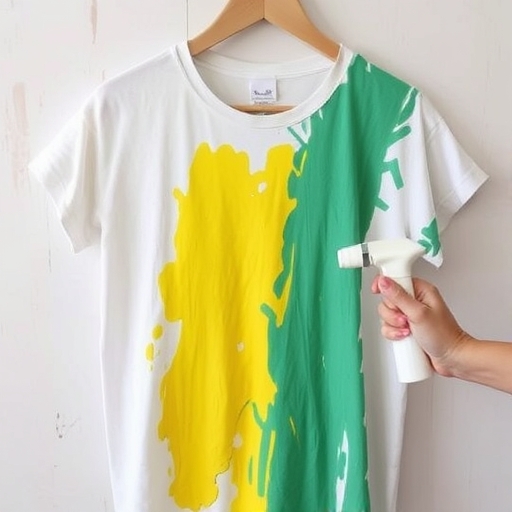Removing Acrylic Paint from Clothes: A Guide
Acrylic paint, beloved by artists for its vibrant colors and quick-drying nature, can be a nightmare when it finds its way onto your favorite clothes. But don’t despair! While fresh paint is easier to remove, even dried acrylic can often be salvaged with the right techniques. This guide will walk you through various methods, from simple home remedies to more intensive approaches, to help you successfully remove acrylic paint from your clothing.
Assessing the Damage: Before You Begin
Before diving into any cleaning method, carefully assess the situation:
Type of Fabric: Delicate fabrics like silk or wool require gentler treatments than sturdy cotton or linen. Harsh chemicals can damage delicate fibers.
Amount of Paint: A small splatter is easier to handle than a large, soaked area.
Age of the Stain: Fresh paint is far easier to remove than dried, cured paint. Act quickly!
Paint Color: Darker colors can leave more stubborn stains.
Paint Type: While the methods below are generally applicable to most acrylic paints, some specialized paints might require different approaches.
Methods for Removing Fresh Acrylic Paint
For paint that’s still wet or semi-wet (meaning it hasn’t fully dried and formed a hard crust), you have a much higher chance of complete removal. Here’s what you should try:
1. Immediate Action: Cold Water and Soap
This is the first and often the most effective method:
1. Act quickly: The faster you address the spill, the better your chances of complete removal.
2. Run cold water: Hold the stained area under cold running water from the back of the fabric. This will prevent the paint from setting further.
3. Gently blot (don’t rub!): Use a clean cloth or paper towel to gently blot the paint. Rubbing will spread the stain and make it harder to remove.
4. Apply laundry detergent: Work a small amount of gentle laundry detergent into the stain and continue blotting.
5. Rinse and repeat: Rinse the area with cold water and repeat steps 3 and 4 as needed until the stain is gone.
2. Isopropyl Alcohol (Rubbing Alcohol)
For more stubborn fresh stains, isopropyl alcohol (70% or higher concentration) can be effective:
1. Test in an inconspicuous area: Always test the alcohol on a hidden seam or area of the garment to ensure it doesn’t damage the fabric.
2. Apply sparingly: Dab a small amount of alcohol onto the stain using a cotton swab or clean cloth.
3. Gently blot: Gently blot the area to lift the paint. Avoid rubbing.
4. Rinse with cold water: Rinse thoroughly with cold water after the paint is lifted.
Tackling Dried Acrylic Paint Stains
Dried acrylic paint is considerably more challenging to remove. These methods require more patience and persistence:
1. Soaking and Scrapping:
This method is best for thicker layers of dried paint:
1. Soak in water: Soak the stained garment in lukewarm water for at least 30 minutes to soften the paint.
2. Gentle scraping: Use a dull knife, spoon, or credit card to gently scrape away as much dried paint as possible. Be extremely cautious to avoid damaging the fabric.
3. Follow with detergent: After scraping, treat the remaining stain with laundry detergent and cold water as described in the “Immediate Action” method.
2. Paint Thinner or Acetone (Use with Extreme Caution!):
This is a last resort method for very stubborn stains and should only be used on sturdy fabrics like cotton or linen and after testing on an inconspicuous area. Always work in a well-ventilated area and wear gloves and eye protection.
1. Test in an inconspicuous area: This is crucial. Acetone or paint thinner can damage certain fabrics.
2. Apply sparingly: Apply a small amount of thinner or acetone to a clean cloth and gently dab at the stain.
3. Blot and rinse: Blot the area and rinse thoroughly with cold water. Repeat if necessary.
4. Launder as usual: After removing as much paint as possible, launder the garment as usual.
3. Commercial Stain Removers:
Several commercial stain removers are designed to tackle acrylic paint. Always follow the manufacturer’s instructions carefully and test on an inconspicuous area first.
Preventing Acrylic Paint Stains
Prevention is always better than cure. Here are some tips to minimize the risk of paint stains:
Wear protective clothing: Cover your clothes with an apron or smock when painting.
Use a drop cloth: Protect your work surface with a drop cloth to prevent spills.
Clean up spills immediately: Act fast to prevent paint from setting.
Keep paint supplies organized: Avoid cluttered workspaces to reduce the risk of accidental spills.
Fabric-Specific Considerations:
The techniques described above can be adapted for different fabrics, but remember that delicate materials require extra care. For delicate fabrics like silk, wool, or rayon, always opt for the gentlest methods first – cold water, soap, and blotting. Avoid harsh chemicals like acetone or paint thinner, which can easily damage these sensitive materials.
Comparison of Methods:
| Method | Effectiveness (Fresh Paint) | Effectiveness (Dried Paint) | Fabric Suitability | Risk of Damage |
|---|---|---|---|---|
| Cold Water & Soap | High | Low | All | Low |
| Isopropyl Alcohol | Medium | Medium | Most (test first) | Medium |
| Soaking & Scraping | Medium | Medium | Sturdy fabrics only | Low |
| Paint Thinner/Acetone | High | High | Sturdy fabrics only | High |
| Commercial Stain Remover | Varies | Varies | Varies | Varies |
Frequently Asked Questions (FAQ)
Q: Can I put the stained garment in the dryer? A: No! Heat will set the stain, making it virtually impossible to remove. Always air dry the garment after attempting stain removal.
Q: What if the stain is on a delicate fabric like silk? A: Use only the gentlest methods, such as cold water and mild detergent, and avoid harsh chemicals.
Q: My stain is still visible after trying several methods. What should I do? A: You may need to accept that the stain is permanent. Consider altering the garment to hide the stain, or repurpose it.
* Q: Can I use bleach to remove acrylic paint? A: Bleach is generally not recommended for removing acrylic paint. It can damage the fabric and may not even remove the stain effectively.
Removing acrylic paint from clothes can be a challenging task, but with patience and the right techniques, you have a good chance of saving your favorite garments. Remember to always test any cleaning method on an inconspicuous area first, and act quickly if possible. Good luck!

